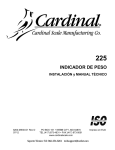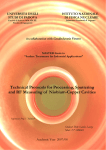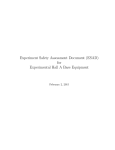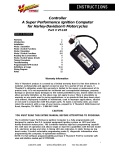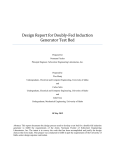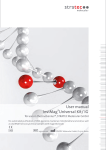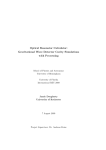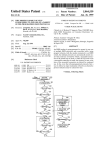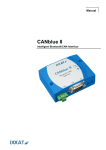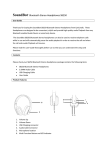Download Karol Krizka - Institute of Particle Physics
Transcript
Summary of Testing Oscillating Superleak Transducers At CERN Karol Krizka August 31, 2010 1 Introduction The development of the International Linear Collider, and other new linear accelerators, requires the capability to mass produce and test a large number of superconducting RF cavities. Furthermore the accelerating gradient must also be high, with around 31.5 MV/m[1] required for the ILC. However right now it is limited to around 25 mV/m[2] for the bulk of the cavities produced. The good news is that the main limitation is the presence of small defects on the surface of the cavity, which can be easily fixed. The bad news is that before it can be fixed, the defects must be diagnosed and located. Several techniques, like T-mapping, already exist for this, but they have some disadvantages. A new, faster, technique has been recently developed at Cornell that uses oscillating superleak transducers (OSTs) to locate the defects via triangulation. It has been used successfully at Cornell[3] and DESY to diagnose several ILC cavities, and it is now starting to be employed at CERN. This report summarises the initial tests done with the OSTs at CERN and presents several recommendations for their setup and operation. In most cases, the location of a quench is determined by measuring the heat emitted by the walls of the superconducting cavity. The maximum surface magnetic field that a superconductor can withstand is limited by the material. If the material is not perfect, for example it contains a small dent on it, then the maximum field that it can withstand is even smaller. So when one reaches this critical field, the material turns from a superconductor into a normal conductors. This process is called a quench and results in all of the energy stored inside the cavity being lost. Since the material is no longer superconducting, then it has some macroscopic resistance. Finite resistance means that the surface currents decay through heat lost to the surroundings. However the adjacent material around this small defect is still superconducting, so no considerable heat loss occurs there. Thus if one can locate the point on the cavity surface that gets hot, then one knows where the defect is located. T-mapping accomplishes this by wrapping the cavity in a multitude of temperature sensors (ie: diodes) and measuring the temperature distribution. The location of a quench will show up as an increase in the temperature on specific sensors. The problem with this technique is that the cavity is very big and the defect is very small, so a very large number of sensors has to be employed. Not only it takes a long time to setup, because the sensors have to be mounted on the cavity itself, but also is very expensive and limited in their resolution. On the other hand, it is very easy to use and has some other diagnostical applications. An alternate technique is to use the oscillating superleak transducers, which detect the “second sound waves” emanating from the quench. Inside superfluid Helium, the state that Helium enters below 2.17 K, heat travels as a wave similar to sound waves. The only difference is that instead of density modulations at constant entropy, second sound consists of entropy modulations at constant density. The most comprehensive explanation of second sound can be found in a paper titled “The Theory of Liquid Helium”[4] by Laszlo Tisza. But in short, superfluid Helium can be described using a two-fluid model. It consists of a normal component and a superfluid component, neither of which interact with the other. Although the net density of the Helium liquid is the sum of the densities of the two components. Another way to put it is that they 1 are separated in momentum space, although not in physical space. The superfluid component is different from the normal component in that it has no viscosity and carries no entropy. This means that all entropy has to be carried by the normal component, meaning if one heats up the liquid then some of the superfluid component is converted into normal component. The reverse is true of cooling down. This fact results in the phenomenon of second sound. Adding heat causes some of the superfluid component to be converted into the normal component, disturbing the equilibrium. There is more normal fluid close to the heater than there is far away, so it starts to flow. The reverse is true for the superfluid, because now there is less of it close to the heater than far away, and so a counter-flow is created. The net result is that there is no net flux of Helium and the total density stays constant. But there is flow of the individual components, which is what the OSTs detect. The OST works basically like a microphone inside the cryostat. It consists of two conducting plates; one plate is held fixed while the other is allowed to vibrate. The vibrating plate is actually a semi-permeable membrane coated with a thin aluminium coating. The membrane is semi-permeable in that it lets the superfluid component through, but blocks the normal component because of its viscosity. This creates a boundary condition that the membrane must follow the flow of the normal component induced by a second sound wave. This motion of the vibrating plate can then be detected, because the two plates are held under a constant voltage difference. Since in essence the two plates form a parallel plate capacitor, the constant voltage creates a charge accumulation on the two plates. But the vibrations mean that the separation of the two parallel plates changes and hence the capacitance changes. In order to maintain the constant voltage across the two plates, the charge on each must change. Thus the second sound waves induces a current to flow, just by causing the membrane to vibrate. The current can be measured and used to determine the presence of second sound. A simplified schematic of the OST system is shown in figure 1. By placing a few OSTs around the cavity, one can measure the time difference between the cavity quenching and the second sound wave arriving at the location of the microphone. Based on this time-of-flight and the knowledge of the speed of second sound, it is possible to determine the distance of the quench from the microphone. Using distances from several OSTs, it is then possible to use GPS-like triangulation to determine the source of the second sound. A pictorial representation of this is shown in figure 2. The time-of-flight to distance conversion requires the knowledge of the speed of second sound waves at the temperature of the Helium bath. For the tests describes in this report, the vapour pressure of the bath was kept at 0.018 bar during the tests, which corresponds to a temperature of around 1.8 K. Using a table from other experiments[5], one finds that the speed of second sound is around 19.8 m/s. The speed, in more useful units for the scales present, is also equal to 0.5 ms/m and 1.98 cm/ms. The advantage of this technique is that the OSTs are very easy to install, because they are very small and can stay mounted on the vertical test stand for several tests. In addition they are very cheap to build, although that is not important because only a small number of them is required. The setups at Cornell and DESY have successfully used only eight OSTs to diagnose a cavity. The OST system is currently being setup and tested at CERN, to test the cavities for the future SPL accelerator. This report describes the initial tests done using the OSTs and several controlled heaters and a special cavity. The tests were performed over the period of one month, after which there was a pause because of cryogenic problems. However enough data was gathered to conclude that a second sound wave was detected and that the OSTs work. Although no precision tests could have been performed, due to the reasons that will be described later. 2 Figure 1: A simple schematic showing the operation of an OST. 3 (a) The OSTs are setup to surround (b) The cavity quenches and generates (c) The wave arrives at the OSTs at the cavity. a second sound wave. different times, depending on the distance. (d) The distance between the quench (e) Triangulation is used to locate the and the OST is determined using the quench. time-of-flight information. This plot is an example of a cavity test done at Cornell[3]. Figure 2: A pictorial representation of using OSTs to diagnose a cavity. 4 2 The Setup At CERN This section describes the OST system that is setup at CERN. The main purpose is not only to introduce the main components of the system, but also to define the terminology used to refer to them. The terminology will be consistently used in further sections. The OST system consists of the OST microphones, the OST circuit, the DAQ device and two power supplies. The two power supplies are differentiated by the voltage that they provide; 120 V DC and ±12 V DC. From now on, the term “OST system” refers to this collection of devices, connected in a normal operational mode. In addition there are a few devices that are not part of the OST system described in this section, because they were consistently used during the testing stage. They include the cryostat housing the OST microphones, heaters used to generate controlled second sound waves and the Quadrupole Resonator cavity located inside the cryostat. The system is heavily based on the one at Cornell. In fact, the OST microphones themselves have been built at Cornell and the circuit was designed there. The only difference is that instead of using oscilloscopes to perform the data acquisition, the system at CERN uses a NI PXI. If the modification is shown to work, then it would be a preferred way to perform the measurements at other institutions. The problem with the oscilloscopes is that they have at most 4 input channels. Since a typical OST system consists of 8 OSTs and each oscilloscope requires its own measurement of the quench trigger (ie: transmitted power) for timing reasons, then one requires at least three oscilloscopes. Such a setup can become quite bulky and unwieldy when compared to a single compact DAQ card. 2.1 The OST System The term “OST” refers to a single oscillating superleak transducer. The term transducer includes everything, with the exception of the power supplies, required to generate a single measurable signal from a second sound wave. This consists of the microphone inside the Helium bath and the circuit that amplifies the signal. There are eight OSTs as part the OST system being tested, which is also the standard number present in other setups. The “OST microphone” is the only part located inside the cryostat. It is the parallel plate capacitor made out of a fixed conducting plate and an oscillating membrane described earlier. The two plates are held under a constant voltage difference of 120 V DC and the capacitance was measured to be around 0.5 nF . A picture of an OST microphone is shown in figure 3. The microphones are mounted on the vertical test stand used to house a superconducting cavity. At the moment, the cavity mounted is a Quadrupole Resonator used for measuring the properties of niobium samples. In addition, the vertical test stand holds three heaters that can be used for creating second sound waves. The heaters and the cavity, along with the tests performed using them, are described later. Figure 4 shows the position of the microphones on the vertical test stand. The OST microphones are then connected to the OST circuit. This circuit is responsible for keeping a constant 120 V DC across the parallel plates and amplifying the current from the second sound signal. The circuit contains an active amplifier, so it requires an additional ±12 V power supply. The schematic of the OST circuit is shown in figure 5. The figure also shows the purpose of the different components found in the circuit. Each OST microphone requires its own circuit, meaning that there are eight circuits in total. All of them have been installed inside a box, called the OST box. The box has several responsibilities; distributing the power to all of the OSTs and exposing a simple interface to connect all of the components together. Figure 6 shows a top view of an opened OST box. The box exposes several connectors to the outside world. The two connectors on the side are for the 120 V (HT 120 DC) and ±12 V (POWER) power supplies. At the front, there are eight BNC connectors, 5 (a) OST microphone mounted on the vertical test stand. (b) OST microphone deconstructed into its individual parts; the back-plate, membrane and a front cover. Figure 3: Photographs of one OST microphone. each presenting a measurable signal for an OST. These connectors are referred to as OST outputs. At the back, there is a single 26-pin connector (IN). This connector is used to connect to the OST microphones located inside the cryostat. Also housed beside the cryostat are the two power supplies. The 120 V DC power supply, Powerbox SB250-1.25, provides the constant voltage across the OSTs. The second power supply outputs a voltage of ±12 V DC. It is used to power to the operational amplifier inside the OST circuits. Both of the power supplies are connected to the OST box using two different cables. The final part of the OST system is a device that can measure and record the signal created by the OSTs. An oscilloscope can be, and was, used to performed quick tests. However the bulk of the data acquisition is done using a National Instruments PXI computer setup outside of the bunker. The PXI consists of several components itself. The components include a NI BNC-2090[6] breakout box connected to an NI 6071E[7] Multifunction I/O board. The MIO board is inside a PXI chassis, along with a NI PXI-8106[8] microcontroller and NI PXI-1031[9] power-supply. The breakout box is used to convert the BNC cables coming from the OST box into a connector compatible with the MIO board. The MIO board is then responsible for the analogue-todigital conversion and gathering of data. The data is then read, stored and analysed using the NI PXI-8106 microcontroller. The microcontroller is just a simple computer that runs Windows XP and is controlled remotely. The problem of using the PXI for bulk of the data acquisition is that its internals are more complicated than an oscilloscope and thus there are more ways to introduce noise in the measurement. It turned out that there were ground loops[10] created, which resulted in a considerable increase in high frequency noise. Although its presence is not detrimental to measuring second sound from a quench, because the signal is much greater, some steps were taken to find the optimal configuration. It turned out that the signal is cleanest when it is gathered using referenced single ended mode, with one of the extra channels connected directly to the building ground. Also a software high-pass filter, with cutoff frequency of 100 Hz, can be used to remove the 50 Hz wave that is prevalent in most measurements. 6 Figure 4: The OST numbers corresponding to the position of the OST microphone on the vertical test stand. 7 Figure 5: The schematic for the OST circuit. It is annotated with explanations for roles that each component plays. Figure 6: The top view of an OST box. When the OST box is in operation, the top is closed by screwing on a metal plate. 8 Figure 7: A schematic of the overall OST system showing: (1) the location of the different components and (2) the connections between them. The overall system is summarised in figure 7. The two power supplies are connected to the OSTs via the OST box, which contains the eight OST circuits. It is responsible for powering and amplifying the signal from the eight OST microphones. The OST microphones are the only part of the OST system located inside the cryostat, while the power supplies and the OST box are located beside the cryostat. The data is then measured using a NI PXI located outside of the bunker housing the cryostat. It is connected to the OST box using long BNC cables. Control of the PXI is accomplished using Remote Desktop. This method of connecting the OST system is referred to as the “normal operational mode” in this report, because it is the most common way to connect the components together. There are a few more intricacies in the configuration, like the acquisition mode of the DAQ, but they will be discussed later. 2.2 External Devices As mentioned earlier, there are a few devices that are not part of the OST system. But even though they do not take part in diagnosing the accelerating cavities, they were used in the preliminary testing of the system. The following is a short description of them. The cryostat is a large, vacuum insulated, tank located inside SM18. The vertical test stand, containing the Quadrupole Resonator and the OST microphones is lowered into it. The filling of the Helium and other cryogenic tasks are performed automatically by the cryogenics staff, but the status of the cryostat can be measured independently. The amount of liquid Helium inside the cryostat can be seen on two gauges inside the control room. The two gauges show a reading that is a linear function of the height of the liquid. The reading can be converted into the height via a table located below the gauges. The temperature of the liquid Helium is indicated by a pressure gauge located above the height gauges. This is the vapour pressure exerted on top of the liquid by the cryogenic pumps. The pressure can be converted into a temperature by looking at liquid Helium vapour pressure tables[11] found online. The liquid Helium is superfluid when the pressure 9 OST # 1 2 3 4 5 6 7 8 Distance (cm) (Error ± 0.5 cm) 69 70 49 49 28 28 14 14 Table 1: The vertical distance of the OST from the bottom “evaporator”. is below 0.05 bars. There are three heaters installed inside the cryostat that can be used to generate second sound inside the Helium bath. Figure 8 shows the locations of the heaters on the vertical test stand. One of the heaters is a giant copper plate located bellow the cavity. The purpose of this copper plate is to evaporate the liquid Helium when emptying the cryostat, thus it is referred to as the evaporator. It has a resistance of 100 Ω. All of the OSTs, with the exception of #1 and #2, are located directly above this heater. This means that the time-of-flight measured by them should correspond to their height. This height was measured independently using a ruler, allowing for quantitative comparisons. This height is shown in table 1. Then there are two smaller, but still large, heaters wrapped around the cavity. These heaters are used for slowly warming up the cavity before taking it out of the cryostat. The resistance of both of them is around 240 Ω. All of the heaters can be powered using one of two power supplies. One of the power supplies is the same type of power supply as the one used to generate the 120 V DC in the OST system. It can create a constant voltage between 0 to 250 V DC and has a very fast turn-on curve. The voltage of this power supply can be seen using an oscilloscope, but not the DAQ setup because of its input voltage limitations. The second power supply is a simple variable transformer called the VARIAC. The VARIAC can transform the power coming from the building power into a 0 V to 260 V RMS AC wave. The amplitude of the wave is controlled by turning the large knob on top. The only way to turn off the VARIAC is to unplug it, since there is no switches located on it. One can also turn the output 0 V, but that does not fully disable the transformer. In order to guarantee a sharp turn on curve, a make shift switch was created in form of a fuse. The VARIAC is typically connected to a plug with its own fuse, and turning the fuse on and off controls the state of the VARIAC. The signal coming out of the VARIAC cannot be measured using an oscilloscope, because doing so triggers the fuse of the circuit that the VARIAC is connected to due to unknown reasons. Finally the Quadrupole Resonator is a superconducting cavity used to characterise samples of niobium by Tobias Junginger. The cavity is mounted to the same vertical test stand as the OSTs and is shown in most of the figures depicting the test stand. It can be quenched, since it is itself superconducting, which induces a second sound signal inside the liquid Helium. In addition, the time of the quench can be detected by observing the transmitted power from the cavity. The transmitted power is measured by splitting off about 1% using a directional coupler and connecting it to the DAQ system using a RF diode. When the cavity quenches, the transmitted wave drops to 0. The second sound generated from the cavity should look different if the quench happens on the sample sample being tested or on the cavity itself. The importance of this will be discussed in the future sections. 10 Figure 8: The position of the cryogenic heaters on the vertical test stand. Heaters 1 and 2 are the cavity heaters. Heater 3 is the evaporator. The heatsink is not shown, because it was not mounted at the time the picture was taken. 11 3 Tests Using Cryogenic Heaters A possible heat source to test the OST system at CERN is any one of the three cryogenic heaters installed on the vertical test stand. The three heaters available for the test are; a copper evaporator at the very end of the vertical test stand and two ring heaters wrapper around the cavity. The locations of the heaters were shown in figure 8. The heaters can be powered using an AC transformer called VARIAC. The VARIAC takes the power from the building’s electrical system and converts it to voltages ranging from 0 V to 260 V. Different output voltages, corresponding to different powers delivered to the heaters, were tested. The their effect on the second sound signal was studied. All of the OSTs are facing downwards, towards the evaporator. The second sound wave emitting from the heater then should travel directly in the vertical direction to each of the OSTs. Since the OSTs are spaced at specific heights, one should be able to calculate the expected time-of-flight difference between OSTs from the difference in their heights. The distance from each of the OSTs is given in table 1. The OSTs are placed approximately 10 cm to 20 cm apart, meaning that the time-of-flight difference between OSTs on adjacent levels is on the order of 5 ms to 10 ms. For the OSTs spaced furthest apart, OST part #3,4 and OST part #7,8, is 36 ± 0.7 cm or 18.2 ± 0.3 ms. The measurements from OSTs #1 and #2 are not discussed inside this report, because they are placed directly above the Quadrupole Resonator. Hence there is not a direct path from the evaporator to the OSTs. Similarly with the two cavity heaters, only OST #3 and #4 have a direct path. The absence of a direct path makes the measurement of the distance more complicated, because one assumption is that the second sound travels in a straight line. But the results from using them had similar characteristics to those done using the evaporator. 3.1 Oscilloscope Tests Before the DAQ setup was used to measure the signal from the OSTs, a test was performed using an oscilloscope. The oscilloscope is very easy to setup and operate, so it is ideal to quickly make sure that the OSTs are functional. In this case, OSTs #8 and #3 were connected to an oscilloscope. Second sound was then generated using the evaporator as a source, with 100 V being applied by the AC transformer. Figure 9 shows the resulting signal seen on the oscilloscope. The measured time-of-flight difference was around 40 ms, which is around twice the amount expected. But there are a considerable number of uncertainties in this measurement. First of all, the evaporator is not a point source and so the initial second sound comes from an unknown point on a plane. Then path to some of the OSTs is blocked by support structures on the vertical test sound, so the second sound might have to take some detours. Finally, the wave on the oscilloscope is quite noisy and it is very difficult to pinpoint the exact start of the second sound signal. Even though there is an obvious difference between the beginning of the signal and the end of the signal in both amplitude and the frequency, the transition is very gradual. Considering these problems, the right order of magnitude is quite satisfactory. In addition, the same test was run at a temperature above the lambda point of Helium. Above this critical point, the Helium liquid is no longer superfluid. This means that no second sound will be generated and so none should be measured. While keeping the Helium’s vapour pressure at 60 mbar, or 2.25 K, there was no second sound signal was seen on the oscilloscope. These two observations, when put together, indicate that what is seen on the oscilloscope is indeed second sound. This means that the OSTs are functional. However it highlights a problem with the current setup. The second sound signal is only around 10 mV in amplitude and increases very slowly. This will make a precise determination of the start of the signal very hard, especially considering the amount of noise introduced in the DAQ setup. 12 Figure 9: The second sound signal seen on OST #8 (CH1) and OST #3 (CH2) using an oscilloscope.x The evaporator was used to generate the second sound. There are two likely explanations for the problems. First of all, the source of the second sound is a very large copper block. Because of its heat capacity and size, it takes a lot of power to heat it up to a larger temperature. As a result, the energy will take some time before it will be released into the Helium bath. Hence a slower turn-on curve for the second sound signal is expected. Then the term that determines the amplitude of the second sound waves[4] depends on the power emitted per area. If all of the 100 W of power being input into the heater is dissipated instantaneously and spreads uniformly over a square with 30 cm sides, the result is 555 W/m2 emitted. If the same power came out of the heatsink installed recently, then the amount of second sound would go up to 12345 W/m2 . The new heatsink should provide a larger amplitude second sound signal. The same problem is present when using either one of the two cavity heaters. Although the power available is smaller, it is spread over a smaller area. At 100 V, but still the power emitted per area is 636 W/m2 . Using these heaters was not much of an improvement. 3.2 DAQ-Based Tests The same test, as the one involving the oscilloscope, was performed using the DAQ setup to acquire the signal from the OSTs. Since a larger number of channels is available on the DAQ card, the signal from all of the OSTs was measured at the same time. The only limitation of the DAQ setup is the increased amount of noise present, as described in the previous section. This makes it even harder to define the exact beginning of the second sound signal. The investigation into the cause of noise was performed only after the data used in this report was acquired. Figure 10 shows the signal recorded on the OSTs when second sound was generated by applying 250 V AC to the evaporator. Figure 11 shows the same plot, but zoomed in on the time at which the second sound signal appears. It also shows the problems with the slow turn-on curve of the heater. It is obvious that there is some second sound signal present, because the measured voltage looks considerable different at the 13 Figure 10: The second sound signal, generated by the evaporator, seen on the different OSTs. OST #6 is showing a flat line, because its circuit was broken at the time. beginning than it does at the end. But the exact point at which this transition happens is impossible to determine, because of its smoothness. However the approximate time-of-flight difference between OST #8 and #3 still appears to be around 40 ms to 50 ms. 4 Tests Using The Quadrupole Resonator One of the possible second sound sources that the OST system at CERN can be tested with is the Quadrupole Resonator[12] mounted on the same vertical test stand as the OST microphones. The resonator is a superconducting pillbox cavity with some modifications. The modification includes a U-shaped tube in the middle and a niobium sample mounted at the bottom. The diagram of the cavity can be seen in figure 12. It is designed to operate in T E011 mode with resonant frequencies of around 400 M Hz, 800 M Hz and 1200 M Hz. For the OST tests, the resonant frequency used was 400 M Hz. Cavity can be used to test the OST system, because just like any superconducting cavity, it can also quench and start radiating heat. The advantage of the cavity over the cryogenic heaters is that the power is emitted more instantaneously. The disadvantage is that the position of the quench is unknown, so it cannot be used to test the OST system in a way that would involve the conversion of the time-of-flight to a distance. It is only possible to see if the time-of-flight is of the right order of magnitude. 14 Figure 11: The same data as seen in figure 10, but showing only the beginning of the second sound signal. The green lines show the approximate time at which the second signal was detected for two of the OSTs. 15 Figure 12: The layout of the Quadrupole Resonator with the locations of the highest magnetic field highlighted in red. They are the most likely locations that a quench will occur. 16 To determine the time-of-flight for the second sound wave, one needs to know at which time the cavity quenched and at which time the second sound arrived at each of the OSTs. The former can be determined by using power transmitted from the cavity as a trigger. The Quadrupole Resonator has two strongly overcoupled antennas for input and output, meaning that almost all of the input power becomes transmitted out. However if a quench occurs, most of the input power escapes as heat into the surrounding liquid Helium bath. This means that after a quench, the transmitted power will suddenly drop to zero. The OSTs are then used to measure the time at which the second sound signal arrives at the OST microphones after the quench. In some cases the cavity managed to recover for a bit and then quench again, but those later quenches were ignored. It might not be ideal to only look at the time-of-flight difference between the quench and the signal, because it is now fully known which quench the signal corresponds to. Most often it should be the first quench after which the cavity did not recover within a few milliseconds, because then the stored energy had time to dissipate through the quench. This is the quench that will be used. But sometime it is impossible to determine the correct quench, even using this criteria. Thus a list of all possible time-of-flight values, corresponding to different quenches, is given. Although the exact location of a quench cannot be known, there are certain parts of the cavity where they are more likely to occur. Simulations of the cavity show that the highest magnetic field occurs at the rods and the niobium sample, so these locations are to be the most likely source of the second sound. This is quite useful, especially if the quench occurs inside the U-shaped tube. In that case, the timeof-flight location problem would reduce to a two dimensions. The second sound wave will travel from the quench location to both openings of the tube. By placing two of the OSTs (OST #1 and #2) above the openings, one should be able to measure the largest second sound signal on them. Then it is also possible to calculate the distance of the quench from the two exits. And the sum of the the two distances should result in the length of the tube, a quantity that has been previously measured to be around 70 cm. In addition, this is quite useful for the experiment that measures the properties of the superconducting sample installed inside the cavity. The critical field of the sample is measured by attempting to quench the sample by raising the magnetic field slowly. However after a quench is detected, it is unknown if it was the sample that quenched or the Quadrupole Resonator. By placing the two OSTs above the U-shaped tube, it is possible to distinguish the two scenarios. If the sample was quenched, then there should be no second sound signal. But if it was the U-shaped tube that quenched, then there will be a second sound signal as described. 4.1 Results One of the tests performed was using a continious wave to power the cavity. The amount of power delivered to the cavity was increased slowly by turning the knob on the RF generator, until a quench occured. Table 2 shows the calculated time-of-flight from each of the OSTs and an example response can be seen in figure 13. When the same tests were performed independently at liquid Helium temperatures above the lambda point, no second sound signal was seen on any of the OSTs. All of the continuous wave quenches exhibited the same pattern; a short while after the quench, the cavity recovered for a millisecond and then quenched again. The table shows the time-of-flight from both of them, but most likely the first quench is most important. The cavity only recovered only for a milliseconds, so the heat emitted from the quench was only disturbed for a small, most likely negligible, amount of time. The same test was also run using pulsed wave mode, with mostly simlar results. In pulsed mode, there are periods of no power being delivered, meaning that the cavity has some time to recover after a quench. The result is that there are multiple quences and multiple second sound signals seen and it is very hard to 17 Figure 13: The OST signal seen when the power was delivered to the cavity using continuous wave mode. The transmitted power is shown in purple. The field was increased slowly. Transmitted Power At Quench 0.031 ± 0.001 0.036 ± 0.001 0.024 ± 0.001 0.026 ± 0.001 0.026 ± 0.001 Time-of-Flight (Quench 1) 1.358 s 1.035 s 1.046 s 1.005 s 0.833 s Time-of-Flight (Quench 2) 1.337 s 1.258 s 1.279 s 1.027 s 1.067 s Table 2: The time-of-flight for the first second sound signal seen when the power was delivered to the cavity using continuous wave mode. 18 connect them. However it might be possible to discern the quench responsible by comparing the duration of the second sound signal with the duration of the quench, because second sound should be generated as long as there is power being put into the Helium bath. This techique resulted in relatively consistent results for time-of-flight in several tests, all at the order of 1 s. The bad news is that for all tests the time-of-flight is on the order of a second. This corresponds to a distance of 20 meters, which is way too big for the scale of the cavity and the cryostat. On the other hand, the data is quite consistent for all of the tests performed. This would indicate that the quench is not random, but has some specific location. Further evidence is that the field that the cavity quenches at is the same in the last three tests. One possible explanation for the observation is that the location of the quench is in a quite isolated place. For example, it if were to occur on the sample, then it must navigate quite a complicated route to get out from the area surrounding the sample to the OSTs. A similar scenario could occur if the quench was on top of the cavity beside the rods, although probably the delay would not be as much as one second. Further investigation and tests are needed to explain the second sound signal seen from the Quadrupole Resonator. 5 Conclusion The report described the OST system at CERN and has shown that the setup works. A second sound wave was detected, although no precision measurements could have been performed. This was because of two reasons; (1) a slow heater that made the determination of the beginning of second sound signal hard to determine and (2) extra noise induced when using the PXI to gather the data. Although both of the problems have been solved, there were no more periods of superfluid Helium afterwards. This made it impossible to run any more tests of the OSTs. The only conclusions that could have been made so far a very far fetching The tests that were run using the cryogenic heaters installed inside the cavity indicate that the OST microphones are functional. The presence of a signal when applying power to the heaters in superfluid Helium, and their absence in normal fluid Helium, indicates that they do indeed work. In addition, the measured time-of-flight had the correct order of magnitude. The problem was that precision tests could not be done using the heaters, because of several reasons. First of all, they do not emit the power instantaneously and they spread it over a large area. The result is that the second sound signal seen on the OSTs has a slow turn-on curve and the beginning is hard to determine. Second, the large area and its non-uniformity makes it impossible tell from which point the first second sound is generated at. To perform more precise tests, a smaller heater was installed. This heater takes the form of a small heatsink with resistance of 100 Ω. It can generate as much power as the other heaters, but spreads it over a much smaller area. Plus being so small, it acts almost like a point source of second sound. But there was no chance to test it, because of delays due to cryogenic problems. The tests run with the Quadrupole Resonator resulted in very confusing observations that are still not completely explained. The time-of-flight for all types of quenches was on the order of a second, corresponding to around 20 m. The size of the cryostat is nowhere close to this scale, so something other must be happening. A possible hypothesis is that the quench occurs in some geometrically obscure place, such as the sample, so the second sound wave must travel through a maze before it reaches a OST microphone. This could cause considerable delay. More tests should be done in the future to solve this problem. For example, one variation of the test should make sure that the quench occurs on the sample. This would show what the expected second sound looks like when it comes from there. Furthermore, it is not recommended the pulsed wave mode be used to drive the Quadrupole Resonator. The modulation of the power allows the cavity to recover from a quench for a while and then quench again. In such scenarios, it is impossible to tell which is the cause of the second sound signal. For a continuous wave, the cavity only quenches once. Although it recovers a few milliseconds afterwards, the recovery only 19 lasts a millisecond. It should not affect the heat radiated from the quench. 6 Acknowledgements Our sincere thanks go to Dr. Zachary Conway and Prof. Georg Hoffstaetter of Cornell University for providing the OST microphones, the schematic for the amplifier circuit and answering some of our questions. Further thanks also go to Felix Schlander from DESY. References [1] James Brau, Yasuhiro Okada, and Nicholas Walker. International Linear Collider Reference Design Report, volume 1. ILC Global Design Eort and World Wide Study, August 2007. [2] T Junginger, W Weingarten, and C Welsch. Analysis of rf results of recent nine-cell cavities at desy. Technical report, DESY, Hamburg, Germany, Oct 2009. [3] Z A Conway, D L Hartill, H S Padamsee, and E N Smith. Oscillating superleak transducers for quench detection in superconducting ilc cavities cooled with he-ii. In Proceedings of LINAC08, Victoria, BC, Canada, 2008. [4] Laszlo Tsiza. The Theory of Liquid Helium. Physical Review, 72(9):838–854, November 1947. [5] Rabi T Wang, William T Wagner, and Russell J Donnelly. Precision Second-Sound Velocity Measurements In Helium II. Journal of Low Temperature Physics, 68(5/6):409–417, March 1987. [6] National Instruments. BNC-2090 User Manual. National Instruments, 1996. [7] National Instruments. DAQ E Series User Manual. National Instruments, 2007. [8] National Instruments. NI PXI-8106 User Manual. National Instruments, 2007. [9] National Instruments. NI PXI-1031 User Manual. National Instruments, 2004. [10] National Instruments. Field wiring and noise considerations for analog signals. Tutorial, June 2010. [11] Christopher D Keith. Helium Vapor Pressure versus Temperature. http://www.jlab.org/~ckeith/ TOOLS/HeVaporTable.html, September 2001. [12] T Junginger, W Weingarten, and C Welsch. Rf characterization of superconducting samples. oai:cds.cern.ch:1233500. Technical Report CERN-BE-2010-002, CERN, Geneva, Sep 2009. 20






















